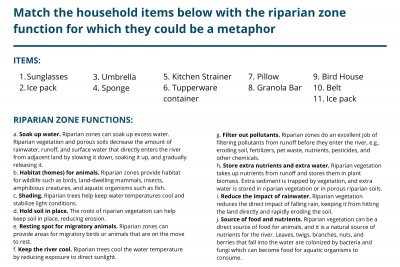Pollution Prevention Curriculum
Unit 3: Riparian Zone
Pre-activity
- List as many plants and animals that you can think of that live in or rely on riparian zones. Think about how this community of plants and animals might be different from those found in a deep forest, in open rangeland, or in your schoolyard. How might they be similar?
- What features of a riparian zone make it different from both the upland and the river channel? Why do these differences occur? Considering the features that are specific to the riparian zone, can you make any guesses about the function or ecosystem role that the riparian zone plays?
- If you have ever been to or seen the river’s edge on the Columbia River, think about this place and describe the riparian condition (e.g. parking lots, lots of tall trees, roads, grass, dirt, gravel...etc…).
Activity 1:
Riparian Metaphors
A metaphor is a figure of speech that describes an object or action in a way that isn't literally true, but helps explain an idea or make a comparison. Use this activity to compare the characteristics, functions, and benefits of riparian zones to common objects. Match the household items below with the riparian zone function for which they could be a metaphor.
Discussion Questions:
- Can you identify other household objects that could also be used as metaphors for the characteristics or functions of riparian zones?
- If a riparian area is disrupted and its functions impaired, what might the consequences be? Think about each of the ecosystem functions listed. For example, riparian zones serve as filters, removing sediment, chemicals, and other pollutants from runoff before it enters the river. If a community gets its drinking water from the river or if people swim and fish in the river and its riparian zone is damaged, what effect could this have on the drinking water and the safety of swimming or consuming fish?
- What would the community have to do to replicate lost ecosystem services of the damaged riparian area?
- Are you familiar with any real life cases of riparian disruption locally? If so, what were the consequences?
Activity 2:
Visit Nichols Natural Area
Print the worksheet before visiting the Nichols Natural Area and use your powers of observation and knowledge of riparian zones to answer the questions. Looking for extra credit? While you are at the site, use the Picture Post and upload your photos.
Nichols Natural Area Location:
1 Nichols Parkway Hood River, OR 97031
Activity 3:
Riparian Plant Capillary Action Experiment
Materials: absorbent paper (like paper towel or coffee filter), scissors, black or color washable (water-based) markers, small bowl or clear cup
- Cut the absorbent paper into strips, about 1-2 inches wide and 5 inches long.
- Draw one horizontal line with the black marker about 1 inch from the bottom of the strip.
- Repeat this step as many times as desired using different colored markers, making sure to use only one color per strip.
- Fill the cup or bowl with just enough water to cover the bottom.
- Carefully place the paper strip into the water in the cup (with the end with the black line near the water, but be careful not to let the black or colored marks touch the water). The water will then wick slowly up the absorbent paper. Water molecules are “sticky” allowing them to stick to themselves (cohesion) and to other things (adhesion) allowing them to “climb” up the absorbent paper. This sticking and climbing is called capillary action and it's the way that plants get water and nutrients from their roots up to their leaves.
- Watch as the water travels up the strip of paper and record any observations.
- How many colors do you see? Do you see more colors on the strip that had the black marking or on the strip with the colored markings?
- The ink in washable markers is often made of colored pigments and water. When water travels up the paper, it brings some of the pigments with it. Black ink is made of a combination of different colored pigments that separate as water passes through. Similarly, when water travels across or through the ground it picks up and transports different substances, just as the ink is dispersed across the paper. Plants root systems can take up or absorb contaminants in the water just like dry paper absorbs the water below it.
Discussion Questions:
- What factors might affect a riparian plant’s ability to absorb water, nutrients and contaminants? (hydrology, steep slopes, duration and severity of rain events, type of vegetation, etc.)
Additional Resources:
- Watch this video to learn about riparian zones and how to improve them:
- Learn more about the Nichols Natural Area.
Welcome to Columbia Riverkeeper’s Hub for Teaching Pollution Prevention to Middle School Students.



